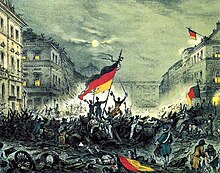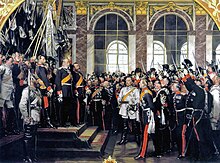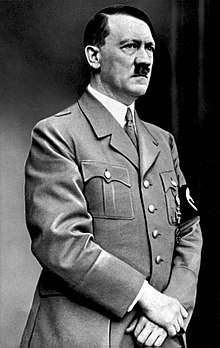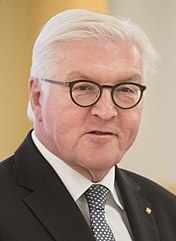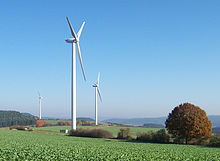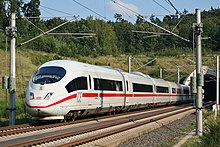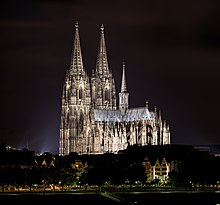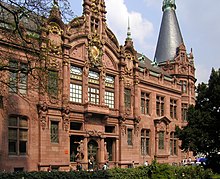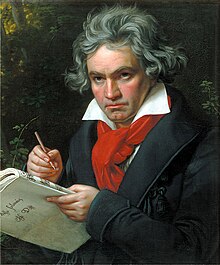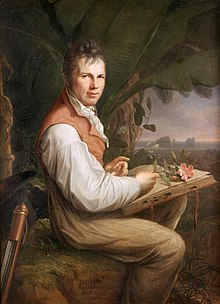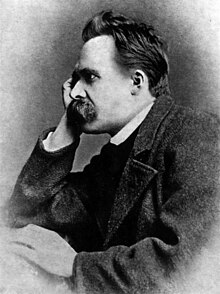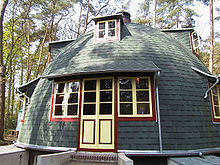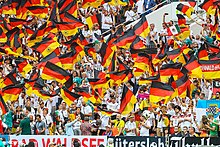Germany
Germany (in German, Deutschland, pronounced/^dtt・lant/(![]() listen)), officially Federal Republic of Germany (in German, Bundesrepublik Deutschland pronounced/рорики /epuѕbli callk хd/tь/(
listen)), officially Federal Republic of Germany (in German, Bundesrepublik Deutschland pronounced/рорики /epuѕbli callk хd/tь/(![]() listen)), is one of the twenty-seven sovereign States that form the European Union. Established in a social and democratic state of law, its form of government is the parliamentary and federal republic. Its capital is Berlin. It is made up of sixteen federated states.Bundesländer) and border north with the North Sea, Denmark, Sweden (race border) and the Baltic Sea; east with Poland and the Czech Republic; south with Austria and Switzerland; and west with France, Luxembourg, Belgium and the Netherlands. The city of Büsingen am Hochrhein, nestled in Switzerland, is also part of Germany. The territory of Germany covers 357 376 km2 and has a temperate climate. With nearly 83 million inhabitants, it is the most populous country among the member states of the European Union, and it is home to the third largest group of international migrants. In 2014, Germany was the second most popular migration destination in the world, after the United States.
listen)), is one of the twenty-seven sovereign States that form the European Union. Established in a social and democratic state of law, its form of government is the parliamentary and federal republic. Its capital is Berlin. It is made up of sixteen federated states.Bundesländer) and border north with the North Sea, Denmark, Sweden (race border) and the Baltic Sea; east with Poland and the Czech Republic; south with Austria and Switzerland; and west with France, Luxembourg, Belgium and the Netherlands. The city of Büsingen am Hochrhein, nestled in Switzerland, is also part of Germany. The territory of Germany covers 357 376 km2 and has a temperate climate. With nearly 83 million inhabitants, it is the most populous country among the member states of the European Union, and it is home to the third largest group of international migrants. In 2014, Germany was the second most popular migration destination in the world, after the United States.
The words German and Germany are Latinizations of the Old Germanic allmanis (composed of all 'all' and man 'man', that is, 'all men'); the Roman historian Ammianus Marcellinus was the first to speak of Alamannia in the IV century, referring to a confederation of Germanic tribes.[citation needed] But these denominations were also used in antiquity by the Romans to name the tribe of the Alemanni (it is not the same as Germans), the Germanic people closest to the territory of the Roman Empire. From there it was used to name the entire country. In addition to German, the use of the adjective Germanic is also widespread, derived from the name with which the Romans referred to the neither Roman nor Celtic tribes of central Europe, whose territory they called Germany. From the year 962, the German territories formed a central part of the Holy Roman Empire, which lasted until 1806. During the 16th century, the northern regions of the country became the center of the Protestant Reformation.
As a modern nation state, the country was unified at the time of the Franco-Prussian War of 1871. After World War II, when Nazi Germany was defeated by the Allies, Germany was divided into two separate states along from the lines of allied occupation in 1949; the resulting states were the Federal Republic of Germany and the German Democratic Republic, which were reunified in 1990. It was a founding member of the European Community (1957), which became the European Union in 1993. It is part of the Schengen area and adopted the common European currency, the euro, in 1999 (cashless payment movement) and 2002 (cash payments).
Germany is a member of the United Nations, NATO, the G-7, the G4 nations, and has signed the Kyoto Protocol. It is the fourth largest world economy in terms of nominal GDP and the first in Europe, being also the main industrial power of the continent. It is also the third largest merchandise exporter in the world and, in absolute terms, allocates the third largest annual budget of development aid in the world, while its military spending ranked seventh in the world in 2020. The country has developed a high standard of living and established a comprehensive social security system. It holds a key position in European affairs and maintains close relationships with various associations worldwide.[citation needed] It is recognized as one of the leaders in the scientific and technological.
Name
The name "Germany" comes from the Germanic people known to the Romans as alemanni or alamanni; first attested by Cassius Dio in the context of a military campaign by Emperor Caracalla in 213. Byzantine historian Agathias (VI) cites Gayo Asinio Cuadrado, who would have written that the alamanni were “a mestizo and mixed people”, which is what their name means. Indeed, alamanni comes from the Proto-Germanic *Alamanniz, with Al, “all” and manniz “men” (ie "all men"). Walafrid Strabo, a monk of St. Gall, wrote in the IX century that the peoples who called themselves Swabians were known as alemanni by foreigners. In Spanish and other Romance languages, the name of this town was used to designate the other Germanic towns and, finally, the German Empire that emerged in 1871.
The name of the country in German is Deutschland, originally diutisciu land, both with the meaning of "German lands" in Spanish, but literally "of the people" in allusion to those who spoke a Germanic language and not Latin. Diutisc, «of the people» comes from the Proto-Germanic þiudiskaz «of the people», the corresponding noun, þeudō, from the Proto-Indo-European *teuta, gave rise to the name Teutones, used for a Germanic people and in Spanish, poetically, as a synonym for Germans.
The Italian adjective for Germans, tedesco, also has this origin, through the Latinized form Theodiscus.
Germania (and its English form Germany) comes from Latin and was used by Caesar to name the peoples who lived east of the Rhine. This place name appears to be of Celtic origin, gair; with the meaning of "neighbors" or gairm; In addition, a Middle High German etymology related to "war cry" has been proposed: gēr, "spear". Neither of these proposals is conclusive. In Spanish, Germanic is used historically, "Germanic peoples", "Germanic Roman Empire", or literary: "Germanic poetry", sometimes including other German-speaking peoples such as Austrians and Swiss.
History
Strictly speaking, Germany did not exist as a state until 1871. Thus, this section also includes previous history: what happened in the territories that later formed part of the German state.
Prehistory and antiquity
The ethnogenesis of Germanic tribes is believed to have occurred during the Nordic Bronze Age or, at the latest, during the pre-Roman Iron Age. From southern Scandinavia and northern Germany, the tribes began their south, east, and west expansion in the 1st century a. C., coming into contact with the Celtic tribes of Gaul, as well as Iran, the Baltic and the Slavic tribes of eastern Europe. Little is known about the early history of the Germanic peoples, except what is known through their interactions with the Roman Empire and from records of archaeological finds.
During the rule of Emperor Augustus, the Germanic peoples became familiar with Roman warfare tactics while maintaining their tribal identity. In the year 9 AD. C., three Roman legions led by Varo were annihilated by the Cherusci and their chief Arminius in the battle of the Teutoburg Forest. Therefore, modern Germany, as far as the Rhine and the Danube are concerned, remained outside the Roman Empire. In Tacitus's time, Germanic tribes settled along the Rhine and Danube, occupying most of modern Germany.
In the III century saw the rise of a large number of West Germanic tribes: Alemanni, Cathi, Franks, Frisians, Saxons and Thuringians. At that time these peoples undertook the period of the great migrations (or barbarian invasions, from the point of view of the Roman Empire) that lasted for several centuries. The Franks established the Frankish kingdom, which conquered several western territories of present-day Germany. Frankish rule was consolidated during the reign of Charlemagne (which lasted from 768 to 814), whose Carolingian Empire absorbed Saxony, Bavaria and Bohemia.
Holy Roman Empire (962-1806)
In 843, the Carolingian Empire was divided among the grandsons of Charlemagne. Francia Orientalis —which included present-day Germany— continued to be ruled by the Franks until 919,[citation needed], the year in which he was crowned Henry I of Saxony. The new German Kingdom, becoming the Holy Roman Empire in 962, continued to exist in various forms until 1806. At its greatest territorial extent, it encompassed all of central Europe, stretching from the Eider River in the north to the Mediterranean coast in the south.
Under the reign of the Saxon dynasty (919-1024), the duchies of Lorraine, Saxony, Franconia, Swabia, Thuringia, and Bavaria were consolidated. Following Otto I's coronation as Emperor in February 962, his new empire encompassed these regions plus the Kingdom of Italy. Under the reign of the Salian dynasty (1024–1125), the Holy Roman Empire consolidated its power over northern Italy. Italy and Burgundy, although the emperors lost their influence in these territories as a result of the investiture dispute, a conflict that pitted the Holy Emperor against the pope. Under the Hohenstaufen emperors (1138-1254), the German princes increased their influence to the south and east, in the territories inhabited by the Slavs. Prosperous cities such as those of the Hanseatic League arose in northern Germany.
The edict of the Golden Bull of 1356 was the basic constitution of the empire that lasted until its dissolution. The election of the emperor was codified by seven prince-electors. Starting in the 15th century, emperors were chosen almost exclusively from among the from the House of Habsburg.
In 1517, theologian Martin Luther wrote his Ninety-five Theses, documents in which he criticized the Catholic Church. This event gave rise to the Protestant Reformation, which acted, in the political sphere and especially in its origins, as a cohesive factor among the multitude of German principalities and, consequently, as a determining factor of what could be called the "German essence". The Lutheran Church was recognized as the representative of the new official religion in many German states after 1530. The resulting religious conflict led to the Thirty Years' War (1618-1648), which devastated the German territory. As a result of the war, the population of the German states fell by 36%.[citation needed] The Peace of Westphalia (1648) ended the religious war between the states Germans, but the Empire was de facto fragmented into numerous independent principalities. From 1740 onward, the rivalry between the Austrian Habsburg Monarchy and the Kingdom of Prussia—both part of the Empire—dominated German history.
In 1795, in the midst of the French Revolution, an attempt was made to save the Empire through the mediatization and secularization of the imperial states. However, this was to no avail. In late 1805, the Empire was invaded and defeated by Napoleon Bonaparte, who established the Confederation of the Rhine. The last Emperor, Francis II, was forced to abdicate and formally declared the Empire's dissolution on August 6, 1806.
Restoration and Revolution (1814-1871)
After the last monarch of the Holy Roman Empire abdicated, a disparate quest to create a unified German national state began in the former states that comprised it. The "German Question" was debated between the creation of a "great Germany", which included the German-speaking territories (promoted by Austria), or a "little Germany" made up exclusively of other States (supported by Prussia). Added to this dilemma was the institutional issue of the distribution of power between the people and the Crown.
The question was posed in a concrete way after the fall of the First French Empire. Napoleon, the Emperor of the French, was defeated, but ending foreign domination did not give the Germans a united Germany within the German Confederation, established in 1815.
In March 1848, revolution broke out in Germany. Converting Germany into a national and institutional state meant having to define what would belong to Germany. The first freely elected Parliament, in Frankfurt am Main, found that it was not possible to force the establishment of a pan-German nation state, including Austria. This fact raised the solution of "little Germany", in the form of an empire under the hegemony of the Kingdom of Prussia.
Parliament demanded that, as German emperor, the King of Prussia would have to renounce his divine character and conceive of himself as executor of the will of the people, a demand that the monarch rejected in 1849, thus preventing it from being carried out. bring about German unification.
In the 1860s, Chancellor Otto von Bismarck in Prussia favored the executive branch over Parliament. The question of external political power was resolved with the Seven Weeks' War in 1866, in which Prussia definitively defeated its Austrian rival.
German Empire (1871-1918)
Germany was unified as a modern nation state in 1871, when the German Empire was forged, with the Kingdom of Prussia as its main constituent. After the French defeat in the Franco-Prussian War, the German Empire (Deutsches Kaiserreich) was proclaimed at Versailles on January 18, 1871. The Prussian Hohenzollern dynasty led the new empire, whose capital was established in Berlin. The empire was a unification of the scattered parts of Germany, except Austria (Kleindeutschland, or "little Germany"). Beginning in 1884, Germany began establishing several colonies outside of Europe.
In the period after the unification of Germany, Emperor Wilhelm I guided foreign policy by ensuring Germany's position as a great nation by forging alliances to isolate France diplomatically, and avoid war. However, during the reign of Wilhelm II, Germany, like other European powers, took an imperialist course that caused friction with neighboring countries. Most alliances in which Germany had previously been involved were not renewed, and new alliances excluded the country. Specifically, France established new relations by signing the entente cordiale with the United Kingdom and gaining links with the Russian Empire. Apart from her contacts with the Austro-Hungarian Empire, Germany found itself increasingly isolated.
At the Berlin Conference, Germany joined other European powers in claiming its share of Africa. Germany obtained ownership over several African territories in the eastern and southwestern part, Cameroon and Togoland. The scramble for Africa caused tensions among the great powers that may have helped create the conditions that led to World War I.
The 1914 Sarajevo bombing, which killed the heir to the Crown of the Austro-Hungarian Empire, sparked World War I. Germany, as part of the Central Powers, suffered defeat against the Allied Powers in one of the bloodiest conflicts of all time. The November Revolution broke out in 1918, and Emperor Wilhelm II abdicated. An armistice ending the war was signed on November 11, and Germany was forced to sign the Versailles Treaty of 1919. In its negotiation, the defeated Powers were excluded in contradiction to traditional postwar diplomacy. The treaty was perceived in Germany as a humiliating continuation of the war by other means, and its harshness is often cited as a factor facilitating the subsequent rise of Nazism in the country. Today, the House of Hohenzollern remains dethroned, though it continues to exist. in the figure of George Frederick of Prussia as crown prince.
Weimar Republic (1919-1933)
Economic adversity, due both to the conditions of peace and the worldwide Great Depression, is considered one of the causes that led to the support of anti-democratic parties by German opinion leaders and voters. Added to this, during the war and until its end, German society had been maintained with the idea that victory was almost certain and the lack of an invasion fed the theory that it was the democratic forces (and communists, as well as the Jews) those who betrayed the homeland and caused defeat (the Dolchstoßlegende or legend of the stab in the back).
In the extraordinary elections of July and November 1932, the National Socialist German Workers' Party (NSDAP, "Nazi party") won 37.3% and 33.1% of the vote, respectively. Political instability and the impossibility of creating a firm government forced the president of the government to appoint the chancellor (Präsidialkanzler), something that was originally the task of Parliament. On January 30, 1933, under pressure from the NSDAP, President (Head of State) Paul von Hindenburg appointed Chancellor (Head of Government) the leader of the NSDAP: Adolf Hitler.
National Socialist Germany (1933-1945)
After Hindenburg's death in 1933, Adolf Hitler was appointed head of state, marking the beginning of Nazi Germany. On February 27, the Reichstag was burned down. Some fundamental democratic rights were later abrogated under an emergency decree. Shortly thereafter, a law gave the government full legislative power. Only the Social Democratic Party of Germany voted against it. her; the communists were unable to present opposition, as their mandates had been canceled and many communists had been killed or imprisoned. A centralized totalitarian state was established by a series of initiatives and decrees, making Germany a one-party state. Public works and the balance between income and expenses of the State reduced the great unemployment that existed, and the rest of the unemployed found employment in the nascent war industries.
In 1936 German troops entered the demilitarized Rhineland, and British Prime Minister Neville Chamberlain pursued his policy of appeasement which ended when he left office. Hitler's policy of annexing neighboring lands—such as Austria and Czechoslovakia—in order to gain Lebensraum (“living space”) led to the outbreak of World War II.
Nazi Germany invaded Poland on September 1, 1939, and two days later the United Kingdom and France declared war on Poland. Initially Germany achieved rapid military successes (hence the term Blitzkrieg: 'Blitzkrieg'). Control was achieved over the Netherlands, Belgium, Luxembourg, northern and western France and later over Denmark, Norway, Yugoslavia and Greece in Europe, and Tunisia and Libya in North Africa. It also had as firm allies the Empire of Japan (which was making its own invasion of Asia and Oceania) and Italy (which had already invaded Albania and Ethiopia, controlled Libya along with the Germans, and attacked Malta and British Egypt). Its allies, or rather satellite states, were the Vichy Government (the southern French part controlled by Marshal Petáin and some of the African and Asian colonies), Finland, Slovakia, Croatia, Hungary, Romania and Bulgaria.
Other states had to collaborate with the Germans so that there would be no reprisals and they would not be invaded. In the summer of 1941, an army of more than three million men invaded the Soviet Union, breaking the non-aggression treaty signed two years earlier. The Germans were supported with huge troops from Finland, Bulgaria, Italy, Romania, Hungary and Spain, among others. Finally, undefeated Germany was stopped in the Battle of Britain, during which the Luftwaffe was defeated by the RAF. The attack on the Soviet Union showed that the Nazi army was insufficient to cover a territory of these dimensions. His failures in the Russian campaigns of 1941 (against Moscow) and 1942 (to obtain oil from the Caspian Sea), as well as the entry of the United States in December 1941, gave a turn in the conflict that led to the destruction of the country under Allied bombing, which only stopped after the capitulation of the Nazi regime on May 8, 1945.
In what later came to be known as the Holocaust, the Nazi regime enacted government policies to enslave various sectors of society: Jews, Communists, Gypsies, Slavs (Generalplan Ost), homosexuals, Freemasons, political dissidents, priests, preachers, religious opponents and people with disabilities, among others. During the Nazi era, some eleven million people were methodically murdered as part of the Holocaust. The Nazi war and genocide were responsible for around fifty million deaths, including six million Jews and three million Poles. The Soviet Union suffered greatly during the war, losing an estimated 27 million people.
Division and reunification
Germany lost a quarter of its territory, which was further occupied and divided among the Allies for about four years until 1949, when civilian governments replaced military governors. An estimated twelve to fourteen million Germans ethnic groups and their descendants were displaced from the former possessions of the Empire. In 1949, after a new Constitution was approved in the west, the Federal Republic of Germany (FRG) was created, which would eventually recover part of its sovereignty, including the ability to maintain an army, and would become integrated, in the West, as a member of the European Communities and NATO. For its part, the German Democratic Republic (constituted in 1949 as a response to the founding of the FRG) would enter from the outset to form part of the Warsaw Pact and the Soviet bloc.
In this way, he embodied the situation that was experienced worldwide in the framework of the Cold War. Berlin, the old capital, was divided into two blocks. The eastern part of the city, under communist control, builds a wall to prevent contact and the flight of its population towards the western part, a phenomenon that had intensified throughout the 1950s, as a consequence of the economic miracle German.
The lukewarm persecution of the Nazi regime's criminals provoked the rejection of the new generations of the FRG, which contributed to the outbreak of the 1968 protests. The GDR, on the other hand, saw itself as a new state, Created by anti-fascist fighters and in no way associated with the Nazi regime. For this reason, and for fear of unleashing political discussions that would endanger the supremacy of the single party, no comprehensive reflection was carried out on what happened during the war. This lack of self-criticism has determined that most of the acts of xenophobia today occur in the former GDR.
After a history of incidents and disagreements between the two German states, the Berlin Wall was opened to traffic on November 9, 1989, after the mass flight of citizens from the GDR to Western territory, which occurred through Hungary and Czechoslovakia in the summer of that same year. Germany was reunified on October 3, 1990, recovering its full sovereignty, when the regime of political and military control of the victorious powers of World War II was definitively abolished.
German reunification had consequences in all spheres of German life, including German participation in UN peacekeeping operations, a more critical attitude towards the contribution of foreigners to German life, and enormous costs for the taxpayers of the old States.
Reunified Germany preserves traditions dating back to the 19th century: universal suffrage and the parliamentary structure, developed in times of the Reichstag. A certain spatial continuity has also been preserved: the Two Plus Four Treaty, the international founding act of reunited Germany, reaffirmed the "little Germany" solution. The agreements established the gradual withdrawal of Soviet troops from East Germany with a guarantee by NATO not to place forces in the east of unified Germany.
Since Robert Schuman, the French minister of German origin, made his famous statement in 1950, both countries, France and Germany, consider themselves the motor of the European communities that have given rise to the current European Union.
Government and politics
It is a federal, democratic, representative and parliamentary republic. The German political system operates under a framework established in the 1949 constitutional document known as the Grundgesetz (Basic Law). By calling the document Grundgesetz, instead of Verfassung (Constitution), the authors expressed their intention that this text would be replaced by a Constitution, once Germany was reunified as a single Condition.
Amendments or amendments to the Grundgesetz generally require a two-thirds majority of both houses of Parliament. But the articles that guarantee fundamental rights, the separation of powers, the federal structure, and the right to resist attempts to overthrow the constitutional and democratic order, are intangible; that is, they cannot be modified. Despite the original intention, the Grundgesetz continued in force after German reunification in 1990, albeit with some modifications.
The Bundeskanzler (Federal Chancellor), currently Olaf Scholz, is the head of government and exercises executive power. His constitutional role is similar to that of a prime minister in other parliamentary democracies, although reinforced by the investiture that the Bundestag grants him personally, and above all by the so-called "constructive vote of no confidence", by virtue of the which Parliament cannot dismiss him if at the same time it does not choose his replacement.
Legislative power rests with the Parliament composed of the Bundestag (Federal Diet) and the Bundesrat (Federal Council), which together form a single type of legislative body. The Bundestag is elected through direct elections, with a system of proportional representation. The members of the Bundesrat represent the governments of the sixteen federal states and are members of the cabinets of each state. The respective state governments have the right to appoint and remove their envoys at any time. Voting in the Bundesrat is en bloc, that is, all the representatives of a Land must vote in the same way.
Since 1949, the party system has been dominated by the Christian Democratic Union (CDU) and the Social Democratic Party of Germany (SPD), although smaller parties such as the Free Democratic Party (FDP, which has had members in the Bundestag since 1949) and Alliance 90/The Greens (Die Grünen, which has won seats in Parliament since 1983) have also played an important role. After reunification, it has also gained parliamentary representation the party Die Linke (The Left), post-communist.
The German head of state is the Bundespräsident (federal president), elected by the Bundesversammlung (Federal Assembly), an institution made up of members of the Bundestag and a number just as state delegates. The second highest German official in the order of precedence is the Bundestagspräsident (president of the Bundestag), who is elected by the Bundestag, being responsible for supervising the sessions of the body. The third and highest official in the Head of Government is the Federal Chancellor, who is appointed by the Bundespräsident after being elected by the Bundestag. The Federal Chancellor can be constructively dismissed through a vote of no confidence by the Bundestag, where a successor is simultaneously chosen.
Foreign Relations
Germany has a network of 226 diplomatic missions abroad and maintains relations with more than 190 countries. In 2011 the country was the third largest contributor to the UN (providing 8%). Germany is a member of NATO, the OECD, the G7, the G20, the World Bank and the IMF.
On the other hand, Germany's development policy is a separate area of foreign policy. It is formulated by the Federal Ministry for Economic Cooperation and Development, being carried out by the implementing organizations. The German government regards development policy as a joint responsibility of the international community. The country was the third largest aid donor worldwide in 2009, after the United States and France.
- European Union
Germany has played an influential role in the European Union (EU) since its creation and has maintained a strong alliance with France and its neighboring countries since 1990. The country has the largest representation in the European Parliament, under of its status as the most populous state in the bloc, and since 2017 it has led the project to refound the European Union. In addition, each year it is the member state whose contribution is the largest to the community budget. In addition to this correlated contribution to national wealth ("Gross National Income resource"), each State collects part of the VAT on behalf of the Union, as well as customs duties on imports from third countries, which which also makes Germany the main net contributor to the EU budget.
Within the EU, Germany exercises the position of "central power". Proof of this was the German Presidency of the Council of the European Union in 2007, it was the twelfth time that Germany assumed the Presidency since this process began in 1958. As usual, although the head of government of Germany was Angela Merkel, it was Frank-Walter Steinmeier, the Federal Foreign Minister, who officiated as President of the Council of the European Union. The highlight of this Presidency was the drafting of the Berlin Declaration, but the greatest achievement was the agreement that gave rise to the European Treaty of Lisbon. Consequently, other EU member states have high expectations about the German presidency of the Council of the European Union in 2020, as this time the German government must manage the post-Brexit EU and the coronavirus disease pandemic.
Armed Forces
The armed forces are called the Bundeswehr; made up of the Army (Heer), the Navy (Deutsche Marine), the Air Force (Luftwaffe), the central medical services and the branches of the joint service aid command. The Bundeswehr is commanded by the Defense Minister in peacetime. When the country is in a state of war, the chancellor is commander-in-chief.
Compulsory military service was abolished in 2011, it lasted nine months and the government allocated 1.6% of GDP for national defense. Due to its high degree of civil technological development in the field of nuclear and aerospace engineering, it is capable of developing nuclear weapons if its government decides. Its military industry produces weapons ranging from tanks, planes, and armored vehicles, to artillery, submarines, and combat ships. Most of the weapons are manufactured for the Federal Armed Forces or for NATO allies.
According to article 24 GG Germany can limit its sovereignty to preserve European or world peace and work together with an international organization. Germany is part of NATO and as such has participated in Afghanistan, Kosovo and the Second Gulf War, among others. In addition, together with the European Union, he worked for peace in Darfur.
Law
The Courts of Justice are independent of the executive and legislative branches. They have a civil statute that is based on Roman law with some references to Germanic law. The Bundesverfassungsgericht (Federal Constitutional Court), based in Karlsruhe (600 km from Berlin), is the German Supreme Court responsible for constitutional matters, with powers to declare unconstitutional laws approved by parliament, the government and the federal president, what in the United States system is called "judicial review".
This Court is the highest judicial authority in the country, and its objective is to ensure that the acts of the legislative and judicial powers comply with the Basic Law. It acts independently of the other organs of the State, but cannot act on its own initiative.
The German justice system consists of more than one supreme court. For civil and criminal cases, the highest court is the Federal Court of Justice, based in Karlsruhe, Leipzig. Other supreme federal courts in their field of action are the Federal Labor Court in Erfurt, the Federal Social Court in Kassel, the Federal Tax Court in Munich and the Federal Administrative Court in Leipzig.
Criminal law and private law are codified at the national level in the Strafgesetzbuch and the Bürgerliches Gesetzbuch, respectively. The penal system is directed towards the rehabilitation of the criminal, its secondary objective is the protection of the general public. To achieve the latter, the convicted criminal can be placed in preventive detention (Sicherheitsverwahrung), in addition to regulating the sentence if he is considered a threat to the general public. The Völkerstrafgesetzbuch regulates the consequences of crimes against humanity, genocide and war crimes.
Legislative power is divided between the federation and the states. The Basic Law stipulates that states must follow the provisions of the legislative power at the state level, except for the cases designated by the Basic Law. Federal law prevails over the laws of each state, since the legislative power resides at the federal level. The Bundesrat is the federal body through which states participate in national legislation. Each state has its own constitutional courts.
Human Rights
In terms of human rights, regarding membership of the seven bodies of the International Bill of Human Rights, which include the Human Rights Committee (HRC), Germany has signed or ratified:
Territorial organization
Germany comprises sixteen states which are collectively referred to as the Länder or Bundesländer. Each state has its own constitution and is largely autonomous in terms of its internal organization. Due to differences in size and population the subdivisions of these states vary, especially between city-states (Stadtstaaten) and states with larger territories (Flächenländer). For regional administrative purposes five states, namely Baden-Württemberg, Bavaria, Hesse, North Rhine-Westphalia and Saxony, consist of a total of 22 government districts (Regierungsbezirke). As of 2009 Germany is divided into 403 districts (Kreise) at the municipal level; these consist of 301 rural districts and 102 urban districts.
|
Geography
Its population is the second largest in Europe (after European Russia), and it is the seventh largest country by area. Its territory covers 357,022 km², consisting of 348,672 km² of land and 8,350 km² of water. The land ranges from the high peaks of the Alps in the south, where the highest elevation is the Zugspitze at 2,963 m, to the lowlands bordering the coasts of the Baltic and North Seas. In the center of the country are the forested highlands and to the southwest the Black Forest. It does not have overseas territories.
Some of its most important rivers are the Rhine, the Elbe, the Danube River and the Main. Among the lakes, the Constanza and the Müritz stand out.
Climate
Most of Germany has a temperate climate with westerly winds. The climate is moderated by the North Atlantic Current, which is the northern extension of the Gulf Stream. This warming of water affects areas bordering the North Sea including the Jutland peninsula and the area along the Rhine, which empties into the North Sea. Therefore, in the northwest and north, the climate is oceanic, the rains occur throughout the year with a maximum during the summer. Winters are cold with temperatures between -15 to 0 °C and summers tend to be cool, with maximum temperatures between 20 and 24 °C and minimum temperatures between 6 and 16 °C for long periods. In the east, the climate is more continental, winters can be very cold with temperatures between -15 to -1 °C, summers can be warmer with temperatures between 21 and 26 °C, for which they are often recorded long dry periods. The central and southern parts are transition regions that vary from moderate to hot climates. Once again, the maximum temperature can exceed 30 °C in summer. The maximum temperature recorded is 41.2 °C in Duisburg-Baerl and in Tönisvort (North-Westphalia) on July 25, 2019, while the lowest temperature recorded is -37.8 °C in Wolnzach (Bavaria) on February 12, 1929.
Effects of climate change
The monitoring report of the German Federal Government (“Monitoringbericht 2019”) shows the following picture for Germany: The last few years were very hot and characterized by long periods of drought and extreme weather events such as storms and heavy rain. The summers in 2003, 2018, and 2019 were the warmest since the beginning of weather records. Air temperatures increased by 1.5°C from 1881 to 2018. In recent decades, a trend of increased heat extremes is emerging. In particular, the number of hot days (> 30 °C) has increased significantly. For example, in 2003, about 7,500 more people died than would have been expected without a heat wave. Months with below-average groundwater levels become significantly more frequent. In the summer months, the rivers contain less and less water. Sea levels in the North and Baltic seas are rising significantly. This causes an increase in the intensity of storm surges. The duration of the vegetation periods is getting longer. An example is the apple blossom season. The proportion of beech has decreased compared to tree species better adapted to drought in hot and dry natural forest reserves. The effects of increased warming are also evident in the significant increase in water temperatures in lakes and the North Sea.
Fauna and flora
Most mammals live in forests where you can find animals such as roe deer, red deer, wild boar, red fox, fallow deer and many mustelids. Beavers and otters are increasingly rare inhabitants of rivers.
Other large mammals that once lived in Central Europe were wiped out, including the aurochs, brown bears, moose, wild horse, European bison, and wolves. Recently some moose and wolves have migrated from Poland and the Czech Republic in search of better supplies, but in the case of the re-establishment of the wolf and the bear it is very problematic due to the bad reputation of these animals among the population.
The golden eagle is only found in the Alps in the Bavarian area and the bearded vulture that was once found in this area was exterminated. The most common birds of prey are the common buzzard and the common kestrel, unlike the peregrine falcon, which is less numerous.
As the country is in an area with a temperate climate, its flora is characterized by extensive wood and coniferous forests. The extensive existing wood is mostly from red beeches. In addition, other trees such as oak, birch or pine are common. Wide areas of flora such as alpine (Bavarian Alps) or subalpine (Black Forest or Harz) stand out.
Currently 29.5% of the state area is forested. This makes it one of the richest countries in forests in the European Union. Among the plants, the white-flowered acacia has a great acceptance in the population, its presence being common. There is also a growing interest in the production of bee flora and mainly cereals (barley, oats, rye, wheat), potatoes and corn. In the river valleys, including the Moselle, the Ahr and the Rhine, the landscape was reshaped for wine production.
Environment
It has the highest carbon dioxide emissions in the European Union (in 2014 it emitted almost 23% of the continent's total CO2 emissions). In 2018 per capita emissions were 9.2 in tCO2, almost double that of France (4.96 tCO2 per capita) and much higher than Spain (5.9 tCO >2 per capita). Much of its electrical energy comes from coal (it owns 7 of the 10 most polluting coal plants in Europe) that use lignite and to extract it one of the largest primary forests in Europe is being destroyed.
Germans believe that action against global warming is necessary, but they are more divided than people in other countries about the urgency of such action. the emissions of 1990 (Germany is allowed per capita emissions higher than those of Spain). Germany has signed several treaties to promote biological diversity, under emission standards, recycling, the use of renewable energy and supports sustainable development worldwide. However, between 1990 and 2017, Germany lost 75% of their flying insects.
Sewage pollution in the Baltic Sea and industrial river tributaries in the former Democratic Germany has been reduced.
Since the early 21st century, Germany has strongly supported the deployment of renewable energies such as solar photovoltaics and electric power. wind energy, contributing significantly to the country's energy mix, where the largest contribution comes from coal-fired power plants. Germany has set itself the goal of producing 35% of electricity from renewable energy by 2020 and reaching 100% by 2050.
Hydrography
The three main rivers are:
- Rhine (German Rhein) with a German part of 865 kilometers has several important tributaries such as the Neckar, the Meno and the Moselle.
- Elba with a German part of 727 kilometers leading to the North Sea.
- Danubio (Donau) with a German part of 687 kilometers.
Other important rivers are the aforementioned Neckar and Meno and others such as the Isar in the southeast, or the Weser in the north.
Economy
Due to the development of its economy, it is considered in general terms as the fourth world power and the first in Europe. In 2006 its gross domestic product (GDP) exceeded 3 trillion US dollars. Its industrial assets are diverse; The main types of products manufactured are means of transportation, electrical and electronic equipment, machinery, chemicals, synthetic materials, and processed foods. It is a source of wealth and this is reflected in the growing economy of central Europe. With an extensive road infrastructure and an excellent standard of living, it is one of the most developed nations in the world.
In the words of former Federal Foreign Minister Joschka Fischer, Germany is the "world champion of exports", given the favorable movement in the country's foreign trade since 2004, which has given the Germans an export surplus.
France is Germany's most important trading partner and vice versa. In 2005, France, with 10.2%, was once again the main destination for German exports and the origin of 8.7% of imports. In 2006, more than 14% of French exports were destined for Germany and about 17% of total French imports came from Germany.
The countries of the European Union are the main buyers of German products (United Kingdom 7.8% and Italy 6.9% in 2005). Germany's main trading partner outside Europe is China, a country to which in 2011 it made 5.7% of its exports and from which it received 9.7% of its imports.
The Deutsche Bundesbank (Central Bank) and the European Central Bank (ECB) have their headquarters in the city of Frankfurt am Main. In 2006 the construction of the building of the European Central Bank was undertaken.
Inequalities are among the highest in Europe and are reflected in low wages in many sectors. Thus, 22.5% of workers earn less than 10.50 euros per hour, compared to only 8.8% in France.
Since 2004, Germany has been facing rising rental prices, which could lead to the bursting of a housing bubble. Between 2016 and 2017, prices in Berlin increased by more than 20% (more than 100% in ten years).
Infrastructure
Transportation
Since Nazi Germany undertook the construction of the world's first large-scale highway network in the 1930s, the country has rapid communication routes (Autobahnen) that add up to about of 12,000 km covering the entire territory. It also has more than 40,000 km of roads, which makes it the country with the highest density of roads for vehicles. All highways in the country are free for private vehicles; As of 2005, cargo trucks must pay a toll that is discounted automatically via satellite, once the truck leaves the route, and that is proportional to the number of kilometers travelled.
The major causes of CO2 emissions come from transport, particularly cars. In this sense, in all EU countries there are speed limits except on the German highways, probably because in Germany there are the parent companies of brands that manufacture the most powerful cars that have acted to give the image of few emitters, it is known the case of dieselgate.
Germany is also a world leader in canal construction. This type of millennial construction gained renewed momentum from the XIX century. The Kiel Canal, which connects the North Sea with the Baltic Sea, is one of the most impressive. Numerous river channels, such as the Rhine-Main-Danube, the Dortmund-Ems or the Elbe-Seitenkanal, provide the country with a complete network of channels.
Cities such as Freiburg im Breisgau have modern facilities for harnessing solar energy. The large industrial regions, such as the Ruhr basin, the Rhine-Main region or Cologne, have developed an economic dynamism that maintains its industrial base and has also been able to implement itself in the area of services.
Media
Germany is the largest television market in Europe, with some 34 million television households. The numerous regional and national public channels are organized according to the federal political structure. Around 90% of German households have cable or satellite television, and viewers can choose from a variety of free public access and commercial channels.
The country is home to some of the largest media conglomerates, including Bertelsmann and the Axel Springer publishing house.
Demographics
With more than 82 million inhabitants, it is the second most populous country in Europe after Russia and the most populous country in the European Union. However, its fertility rate of 1.54 children per woman is one of the lowest in the world, and the Federal Statistical Office estimates that the population will drop to between 68 and 73 million by 2060. Germany has a number of large cities, Berlin being the most populated, however, the largest urban agglomeration is the Rhine-Ruhr region.
Since December 2004, some seven million foreign citizens have been registered, and 19% of the country's residents are foreigners or have some foreign origin. The largest group (2.3 million) is from Turkey, and most of the rest are from European countries such as Italy, Serbia, Greece, Poland and Croatia. The United Nations ranks Germany as the third largest recipient. of international emigrants worldwide, around 5%, or 10 of the 191 million emigrants, or around 12% of the country's population. As a consequence of the restrictions, the number of immigrants seeking asylum justifying origin German ethnicity (mostly from the former Soviet Union) has been steadily declining since 2000.
The population pyramid of Germany (13.3% young, 66.1% adults and 20.6% elderly), is one of contraction, common in highly developed countries with low birth rates and low mortality rates. This usually indicates that there is a long life expectancy, high educational level, and good medical care.
Religion
Christianity is the majority religion, with 45.8 million believers (55.1%). The second most widespread is Islam, with 4.3 million followers (5.2%), followed by by Buddhism and Judaism, both with around 200,000 adherents (0.25%). Hinduism has about 90,000 adherents (0.1%). All other religious communities have less than 50,000 (or less than 0.05%) adherents. About 32.3 million Germans (38.8%) have not registered a religious denomination.
Protestantism is concentrated in the north and east and Catholicism is concentrated in the south and west. Each of them comprises about 29% of the population; 1.7% of the total population declare themselves Orthodox Christians, among them Serbs, Russians and Greeks are the most numerous. Pope Benedict XVI was born in Bavaria.
The number of people without religion, including atheists and agnostics, amounts to 38.8% of the population, and they are especially numerous in the former East Germany and major metropolitan areas. Of the 4.3 million of Muslims, the majority are Sunnis and Alevites from Turkey, but there are a small number of Shiites.
According to the 2005 Eurobarometer survey, 47% of German citizens answered "I believe there is a God," while 25% answered "I believe there is some kind of spirit or life force" and 25% said "I don't believe there is any kind of spirit, God, life or force".
Languages
German is the official and main language spoken in Germany. It is one of the 23 official languages of the European Union and one of the three working languages of the European Commission, along with English and French.
In addition to German, there are other officially recognized languages, one of them at the regional level (Regionalsprache) –Low German–, and the others as minority languages (Minderheitensprachen), being Danish, the Sorbian languages (Lower Sorbian and Upper Sorbian), North Frisian, Saterland Frisian, and Romani.
The most widely used foreign languages in the country are Turkish, Arabic (particularly since the waves of refugees in the second half of the 2010s), Polish, the languages of the Balkan Peninsula and the Russian.
Standard German is a West Germanic language and as such is related to English, Danish, Frisian, Norwegian, Dutch and the Nordic languages. The majority of German vocabulary is derived from the Germanic branch of the Indo-European language family. Significant word minorities originate from Latin, Greek, and a smaller amount from French. German is written using the German alphabet, being basically the Latin alphabet (with its twenty-six letters) reinforced by three vowels with Umlaut –ä, ö and ü–, and a consonant, the Eszett –ß– (also called scharfes S, in Spanish "s strong").
Worldwide, German has about 100 million native speakers and about 80 million non-native speakers, and is the primary language of about 90 million people in the European Union (18%). 67% of German citizens claim to be able to communicate in at least one foreign language, and 27% in at least two.
Education
Responsibility for educational supervision lies mainly with the individual federal states, while the government has only a secondary role. Kindergarten is optional, providing education for all children between the ages of three and six, after which schooling is compulsory for at least ten years. Primary education usually lasts four years and public schools are not stratified in this stage. In contrast, secondary education includes four types of schools based on student ability as determined by teacher recommendations: the Gymnasium, which includes the most intelligent children, prepares students for university studies, and the assistance lasts eight or nine years, depending on the state; the Realschule has a wider range of special interest for intermediate students and lasts six years; the Hauptschule prepares students for professional education, and the Gesamtschule combines all three approaches.
The PISA Report assesses the skills of 15-year-old students in the countries of the Organization for Economic Cooperation and Development and a number of partner countries. In 2006, German schoolchildren have improved their position over previous years, ranking (statistically) significantly above average (rank 13) in science, and not significantly above or below average in mathematics (rank 20) and reading skills (rank 18). Socioeconomic differences are high, and student achievement is more dependent on this factor than in most other countries.
To enter a university, high school students need to pass the Abitur exam, similar to the Advanced Level, it is also possible to enter university with a Fachabitur, which is a specialized Abitur, for example, in economics. Students holding a diploma from a vocational school can enter a University of Applied Sciences. Most German universities are state-owned. In all universities you have to pay administrative taxes, which are between 50 and 200 euros. In some States, you also have to pay tuition fees that amount to up to 500 euros per semester.
The universities are internationally recognized, indicating the high level of education in the country. According to the QS World University Rankings 2013, thirteen German universities are among the top two hundred best universities in the world.
Cities
The top fifteen German cities by population (2010) are as follows:
Culture
The country is often called Das Land der Dichter und Denker (the land of poets and thinkers). German culture began long before the rise of Germany as a nation-state and spanned the entire the German-speaking area. From its roots, culture in Germany has been shaped by the main intellectual and popular currents in Europe, both religious and secular. As a result, it is difficult to identify a certain German tradition apart from the broader framework of European high culture. Another consequence of these circumstances is the fact that some historical figures, such as Wolfgang Amadeus Mozart and Nicholas Copernicus, among others, although they were not citizens of Germany in the modern sense, must be considered in the context of the German cultural environment in order to understand their worked.
Science
Germany has been home to some of the most outstanding researchers in different scientific fields. Thus, nearly 100 Germans (by nationality or origin) have been awarded the Nobel Prize. The work of Albert Einstein, Max Planck, and Otto Hahn was crucial to the founding of modern nuclear physics and chemistry, which Werner Heisenberg and Max Born further developed. They were preceded by physicists such as Hermann von Helmholtz, Joseph von Fraunhofer, and Daniel Gabriel Fahrenheit. Wilhelm Conrad Röntgen discovered X-rays, an achievement that made him the first winner of the Nobel Prize in Physics in 1901. In Germany and other countries, X-rays are called "Röntgenstrahlen" (Roentgen rays). Heinrich Rudolf Hertz's work in the field of electromagnetic radiation was fundamental to the development of modern telecommunications. Wilhelm Wundt is famous for having developed the first laboratory of psychology, giving it the status of a science. Alexander von Humboldt and his work as a natural scientist and explorer was foundational for biogeography.
Numerous important mathematicians were born in Germany, including Carl Friedrich Gauss, David Hilbert, Bernhard Riemann, Gottfried Leibniz, Karl Weierstrass, and Hermann Weyl. Germany has also been home to famous inventors and engineers, such as Johannes Gutenberg, who is credited with inventing the movable type printing press in Europe; Hans Geiger, the creator of the Geiger counter, and Konrad Zuse, who built the first fully automatic digital computer. Inventors, engineers, and industrialists, including Count Ferdinand von Zeppelin, Otto Lilienthal, Gottlieb Daimler, Rudolf Diesel, Hugo Junkers, and Karl Benz helped shape the modern automobile and air transportation technology.
Important research institutions are the Max Planck Society, the Helmholtz-Gemeinschaft and the Fraunhofer Society. These work independently or externally connected to the university system, contributing to a considerable extent to scientific production. The prestigious Gottfried Wilhelm Leibniz Prize is awarded to ten scientists and academics each year. With a maximum award of €2.5 million, it is one of the most highly endowed research prizes in the world.
Literature and philosophy
German literature dates back to the Middle Ages and the works of writers such as Walther von der Vogelweide and Wolfram von Eschenbach. Various German authors and poets have gained great renown, including Johann Wolfgang von Goethe and Friedrich Schiller. Collections of folk tales published by the Brothers Grimm popularized German folklore internationally. Influencing authors of the 20th century include Thomas Mann, Bertolt Brecht, Hermann Hesse, Heinrich Böll and Günter Grass.
Germany's influence on philosophy is historically significant, and many notable German philosophers have helped shape Western philosophy since the Middle Ages. Gottfried Leibniz and his contributions to rationalism, Immanuel Kant, Georg Wilhelm Friedrich Hegel, Friedrich Wilhelm Joseph Schelling and Johann Gottlieb Fichte who forged idealism, Karl Marx and Friedrich Engels formulated communist theory, Arthur Schopenhauer developed the composition of metaphysical pessimism, Friedrich Nietzsche developed Perspectivism, Martin Heidegger's work on Being and Time, and Jürgen Habermas's social theories were especially influential.
Art
Numerous German painters have enjoyed international prestige through their work in various artistic trends. Lucas Cranach the Elder, Hans Holbein the Younger, Matthias Grünewald, and Albrecht Dürer were important artists of the Renaissance, Caspar David Friedrich of Romanticism, and Max Ernst of Surrealism.
Architecture
Throughout its history, Germany has experienced the influence of different architectural styles that have been incorporated and adapted to regional tastes. Prominent among the German contributions were the Carolingian and Ottonian styles, which were important precursors to the Romanesque. The region later became the site of important works in styles such as Gothic, Renaissance, and Baroque. It was especially important in the early modern movements, especially thanks to the Bauhaus founded by Walter Gropius. Mies van der Rohe became one of the world's most renowned architects in the second half of the XX century and the use of glass facades in skyscrapers is his idea.
German architectural heritage is extremely important. There are 41 places in Germany distinguished as Unesco world heritage sites, almost all of them with important architectural works.
History of German architecture
Since Carolingian times, under the impulse of the emperor and the prelates, Germany endowed itself with numerous religious buildings, of which very few remain. We can mention the palatine chapel of Aix-la-Chapelle with its central plan, due to Eudes de Metz, it is heir to antiquity. Its plan is reminiscent of that of St. Vitale in Ravenna or of the churches of the East, although it is not clear whether Eudes himself would have seen such buildings or merely sketches sent to him. The other innovation specific to the Carolingian period is the western massif or Westwerk of churches. It is a quasi-autonomous building body in relation to the nave and located to the west consisting of a massive multi-storey tower, often framed by two stair turrets. The ground floor comprises a vaulted entrance porch that houses relics. The first floor, which acts as a chapel, is a gallery open above the nave by bays. The most famous example is Corvey Abbey Church. The latest jewel of Carolingian architecture is the Fulda Abbey Church, which is almost the size of a Gothic cathedral. It was built by the monastery's architect and abbot, Ratgar.
The restoration of imperial authority in the X century was accompanied by a renewal of religious architecture. Large wooden carpentry churches of harmonious proportions were built, such as St. Michael in Hildesheim and St. Cyriac in Gernrode.

From the 11th century century, the Rhenish Romanesque style developed. It is characterized by the existence of three apses that form a trefoil, as in the church of Santa María del Capitolio in Cologne. It was at that time that the Espira and San Martín de Mainz were built. Little by little, the architecture of the churches was influenced by the Gothic style: the Naumburg cathedral and the churches of Limbourg, of Andernach, although they maintain their Romanesque appearance, have a structure closer to Gothic.
Gothic art didn't really spread in Germany until the middle of the 13th century. Erwin von Steinbach was the first master builder of Strasbourg Cathedral, then an integral part of the Holy Roman Empire. Cologne Cathedral is one of the masterpieces of German Gothic with its two tall naves and two façade towers in the French fashion. German originality appears in the use of brick, mainly in the north of the country (Church of St. Mary in Lübeck, Schwerin Cathedral). The adoption of hall-churches (Hallenkirche), inspired by Cistercian architecture, is another characteristic of German Gothic. The side naves rise to the same level as the central nave and are separated from it only by pillars as at Sainte-Élisabeth de Marbourg. Between the centuries XIV and XVI, dominated the late Gothic with the erection of the church of St. Anne Annaberg-Buchholz, a fine example of Saxon Flamboyant Gothic, and Ulm Minster. In the bourgeoisie, houses with pinion (Regensburg), half-timbered houses (Goslar) or fitting out towers in the Italian fashion are built.
During the Renaissance, Germany was influenced by Italy to the south and Flanders to the north. The Renaissance architect Heinrich Schickhardt has marked Germany (Herrenberg-Freudenstadt), but also France (Montbéliard) with his style. Baroque architecture, which appeared in Italy in the early 17th century century, spread to Germany after the Thirty Years' War. The masters of Germanic Baroque art were Johann Michael Fischer (Zwiefalten, Ottobeuren), the Asam brothers and Dominikus Zimmermann Steinhausen, Wies). In Bavaria, Johann Balthasar Neumann carried out the Wurzburg residence in a specific style of the German Baroque. In Dresden, Matthäus Daniel Pöppelmann built the Zwinger Palace. The Frederican Rococo developed in Prussia, led by the architect Georg Wenzeslaus von Knobelsdorff whose main work is the Sanssouci Palace. Andreas Schlüter worked on many monuments in Berlin.
Since 1750, excavations at Pompeii focused on Greco-Roman art. The century saw the advent of neoclassical architecture. This architectural style, whose main theoretician was Winckelmann, advocated a return to classical Greek architectural lines in response to the more charged style of Baroque and Rococo. Leo von Klenze drew the plans for the Munich Glyptotek while Carl Gotthard Langhans erected the Brandenburg Gate in Berlin. French art was in vogue and many French architects were employed by German princes.
Since 1850, the architects E. Ludwig and A. Koch called for a form of art more adapted to their time. The architecture of the XIX century is marked by the diversity of styles. Karl Friedrich Schinkel is a representative of Prussian neoclassicism. The neo-Gothic style, born in England in the middle of the 18th century, was echoed in Germany at the beginning of the XIX. Associated with romantic nationalism, it reinforces the Germans in their national feeling. The reconstruction of the Cologne Cathedral (1842-1863) is a perfect example. In the middle of the XIX century, Biedermeier architecture, highly appreciated by the bourgeoisie, advocated an elegant but sober style both in the facades as in furniture. It corresponds to the French Louis Philippe style. At the end of the 19th century, art nouveau, and more precisely Jugendstil, flourished in Germany. The movement claimed a renewal of forms and materials. The facades were decorated with plant motifs.
Contemporary architecture
At the beginning of the 20th century, twelve industrialists and a dozen artists, including Peter Behrens, Richard Riemerschmid, Henry van de Velde, grouped around the theories of Hermann Muthesius founded the Deutscher Werkbund. The notion of industrial aesthetics was emphasized as shown by the objectives and philosophy of the movement: «Elect the best representatives of the arts, industry, trades and commerce; coordinate all efforts towards achieving quality in industrial production, create a meeting point for all those who have the ability and will to make quality products [...]. There is no fixed border between the tool and the machine. Quality works can be created indifferently with the help of tools and machines as soon as man takes control of the machine and turns it into a tool."
In 1919, Walter Gropius founded the Bauhaus, a school of art and architecture that also taught design and theater. It taught how to use modern materials and reflected on what art should be at the time of industrialization. The Bauhaus hired renowned architects to serve as directors and teachers. Among them, Ludwig Mies van der Rohe —director of the Bauhaus in 1930-1933 and organizer of the Weissenhof project— and Erich Mendelsohn, —creator of the Einstein Tower—, founded in 1926, the Der Ring architectural movement that reflected the functionalist aspect of the buildings. The Bauhaus also allowed the emergence of highly talented designers, including leading designers of the modernist movement, such as Marianne Brandt, Marcel Breuer, Le Corbusier and Charlotte Perriand, the Dutchman Gerrit Rietveld, author of a famous cubist chair. The Bauhaus also influenced photography, costumes, and dance.
After 1945, the urgency in the country was to rebuild a war-torn Germany. It was about quickly offering new accommodation: functionality and economic criteria were privileged at the expense of the quality of the habitat. This sad architecture is still very present in the German territory and Alexander Mitscherlich speaks of an "inhospitable environment" to describe this anonymous architecture. It was not until the mid-1970s that a renovation took place and priority was given to designing a more humane architecture.
After the reunification of 1990, Germany wanted to make its capital a city of international stature. He invited architects from all over the world. Norman Foster (Reichstag Palace), Renzo Piano (Debis Tower on Potsdamer Platz), Richard Rogers, Daniel Libeskind, Rafael Moneo, Helmut Jahn transformed Berlin with their buildings that gave the city an international and resolutely modernist dimension. Axel Schultes designed the new Chancellery. But architectural innovation exceeded the limits of this city: buildings in the new style were erected in Munich (Pinakothek der Moderne) in Herford (MARTa museum), near Neuss (Langen Foundation) and Leipzig (Museum of Visual Art).
Far from prestigious projects, Germany is also at the forefront of green construction (solar energy and non-polluting materials such as wood, energy saving...). In this area, the elderly architect Frei Otto is famous for his flexible suspended ceiling constructions. German civil engineering is currently a leader in this emerging field. There are also examples of modern and innovative architecture in Germany designed to meet the needs of man.
Music
| Johannes Brahms Symphony n. 4 | Felix Mendelssohn Concert for piano n. 1 | Robert Schumann Concert for piano | Ludwig v. Beethoven Symphony n. 5 |
|---|---|---|---|
日本語 style="text-align:left; background:silver;" |
|| style="text-align:left; background:silver;" | |} Some of the most renowned composers of European classical music have developed in Germany, including Johann Sebastian Bach, Georg Friedrich Händel, Ludwig van Beethoven, Robert Schumann, Felix Mendelssohn, and Johannes Brahms. As of the year 2006, Germany is the fifth music market in the world and has influenced music, becoming a pioneer of some genres such as electronic music, industrial metal, pop, rock through artists such as Modern Talking., Rammstein, Lacrimosa, Kraftwerk, Scorpions, Accept, Helloween and Tokio Hotel.
Cinematography
German cinema was especially influential during the years of the Weimar Republic, with German Expressionists such as Robert Wiene (The Cabinet of Doctor Caligari) and Friedrich Wilhelm Murnau. The Nazi era produced significant works such as the film Münchhausen (1943) or the controversial work by director Leni Riefenstahl.
During the period 1970-1980 directors such as Volker Schlöndorff, Werner Herzog, Wim Wenders, Rainer Werner Fassbinder brought German cinema back onto the international scene with their often provocative films. More recently, films such as Das Boot (1981), Lola rennt (1998), Good Bye, Lenin! (2003), Gegen die Wand (2004), Der Untergang (2004) and Das Leben der Anderen (2007) have enjoyed international success.
The Berlin Film Festival, held annually since 1951, is one of the most prestigious film festivals. The annual European Film Awards ceremony is held every two years in the city of Berlin, where the European Film Academy is located. The Babelsberg studios in Potsdam are the oldest large-scale studios in the world and are an international center for film production.
Gastronomy
German cuisine varies from region to region. The southern regions of Bavaria and Swabia, for example, share a culinary culture with Switzerland and Austria. Pork, beef, and poultry are the main varieties of meat consumed, with pork being the most popular. Throughout all regions, the meat is often eaten in the form of a sausage. More than 1,500 different types of sausages are produced in the country. So-called organic foods have gained a market share of around 3.0% and this is expected to be a growing trend.
Breakfast is usually a selection of cereals and honey or jam with bread. Some Germans eat cold cuts, eggs and/or cheese with bread for breakfast. More than 300 types of breads are known throughout the country. Being a country of immigrants, it has embraced many international dishes. Italian dishes such as pizza and pasta, or Turkish and Arab dishes such as kebabs are well established, especially in large cities. Chinese and Greek restaurants are also quite widespread.
Although wine is becoming more popular in many parts of Germany, the national drink is beer. Beer consumption per person in the country is declining, but at 116 liters per year it is still among the highest in the world. Of 18 Western countries surveyed, per capita soft drink consumption was found to be below average (14th on the list), while fruit juice consumption is one of the highest (3rd on the list).
Society
In 2006, Germany carried out the land of ideas marketing campaign in order to promote itself during the final phase of the 2006 FIFA World Cup. In 2008 the project was resumed. «Land of Ideas» focuses on recent innovations in public and private institutions, in universities and research institutes, in companies and even in social and cultural projects.
Since the World Cup celebrations in 2006, the internal and external perception of the country's image has changed. In global surveys known as the GMI Anholt Index, the country ranked second. Economic criteria, the reputation of the country in terms of culture, politics, its citizens and its tourist attraction were taken into account.
Germany is both legally and culturally a tolerant country towards homosexuals. On June 30, 2017, homosexual marriage was approved, with the votes in favor of the Social Democratic Party, The Greens and the Left. Gays and lesbians can legally adopt their partner's children.
During the last decade of the 20th century, Germany changed its attitude towards immigrants considerably. Despite approximately 10% of the population being foreigners, until the mid-1990s public opinion was that Germany was not a country of immigration. However, asylum laws were tightened considerably in that decade to prevent its abuse.
Germans invested €58 billion in international travel in 2005, making them world champions in travel. The most popular destinations were Austria, Spain, Italy and France.
Sports
Germany's participation in the Olympic Games has been one of the most outstanding since this event took place. The country organized two summer editions in Berlin 1936, another in Munich 1972 and a winter one in Garmisch-Partenkirchen 1936.
Germany won the most gold medals and total medals during the Berlin 1936 Summer Olympics and Turin 2006 Winter Olympics, Salt Lake City 2002, Nagano 1998, Albertville 1992 and as East Germany in Sarajevo 1984.
The German Olympic Sports Federation (DOSB) has more than 27 million members. According to data from this organization, approximately a third of the country's population practices sports through a club or association in some of the more than 200,000 sports facilities that exist in the territory and in the 2,400 clubs in the country. For its part, the German Football Federation (DFB) has more than 26,000 clubs, totaling 6 million members, the largest membership of any sports federation in the world.
The German soccer team has won four World Cups (Switzerland 1954 against Hungary in the so-called Miracle of Bern, West Germany 1974 against the Netherlands, Italy 1990 and Brazil 2014 against Argentina) and three European Championships (1972; 1980 and 1996). On three occasions he reached the Eurocup final without winning it (1976, 1992 and 2008). Likewise, the country hosted the world championships in 1974 and 2006. On July 2, 2017, the German team was crowned champion of the FIFA Confederations Cup for the first time, this being the last trophy missing in their ranks. For its part, Germany also stands out in women's football, a category in which it has won two world champion crowns in 2003 and 2007 and is the top winner of the continental tournament. This makes Germany, to this day, the only nation in the world of all those affiliated with FIFA to have been crowned world champion in both men and women.
The national league, (known as the Bundesliga) is considered one of the top 10 leagues in the world. Clubs like Bayern Munich, Borussia Dortmund and Hamburg SV are the only ones from their country to be European Cup champions; while there are other historic clubs such as VfB Stuttgart, Werder Bremen, F. C. Cologne, Borussia Mönchengladbach and Eintracht Frankfurt. Footballers such as Franz Beckenbauer, Karl-Heinz Rummenigge, Lothar Matthäus and Matthias Sammer are the only ones from their country to win the prestigious Ballon d'Or. Other world-renowned stars include Gerd Müller, Sepp Maier, Bernd Schuster, Jürgen Klinsmann, Oliver Kahn, Michael Ballack, Marco Reus, Thomas Müller, among others.
When it comes to motorsport, Germany is one of the leading nations in the world. With numerous race winning cars as German drivers. Precisely the most successful Formula 1 driver in history is the German Michael Schumacher. Sebastian Vettel also stands out with four world titles with the Red Bull team in 2010, 2011, 2012 and 2013 plus two runners-up in 2009 and 2017, the latter with the Ferrari team and Nico Rosberg world champion in 2016. Among the German drivers it is worth noting Nicolas Hülkenberg or Christian Vietoris, who were proclaimed champions in the A1 Grand Prix in the 2006/07 season. Germany is also known for its most famous Formula 1 team, Mercedes-Benz, and for its rally-winning cars such as Audi, Porsche, BMW, Volkswagen, among others.
Cycling is also a popular sport in Germany and one of the greatest cyclists of recent times, Jan Ullrich, Olympic champion, world time trial champion in 2001 and winner of the Tour de France in 1997 finishing second five times. Germany also stands out in track cycling, a modality in which it has won several world championships.
In field hockey, Germany has won two gold medals in the men's field hockey world championship tournament, one in the 2002 World Men's Field Hockey Championship and another in 2006; and two other gold medals in the women's tournament, one in 1976 and another in 1981.
Tennis has had great successes. Steffi Graf is considered one of the best tennis players in history, occupying the number one position in the WTA ranking in 1987 for a total of 377 weeks (current record), in addition to having to her credit a total of 22 Grand Slam titles., historical record in the Open Era. She also won the gold medal at the 1988 Seoul Olympics. Boris Becker is another outstanding tennis player who reached number 1 in the ATP ranking in 1991 and has six Grand Slam titles.
Other notable German athletes include rower Andreas Dittmer, athlete Dieter Baumann, golfers Bernhard Langer and Martin Kaymer, swimmers Kristin Otto and Michael Gross, boxer Max Schmeling and basketball players Dirk Nowitzki, winner of the MVP award of the NBA in the year 2007 and champion of the NBA 2011 and MVP of the Finals 2011, Detlef Schrempf, Shawn Bradley, Chris Kaman and Dennis Schröder.
Contenido relacionado
Aachen
The Port of Santa Maria
Brazil






